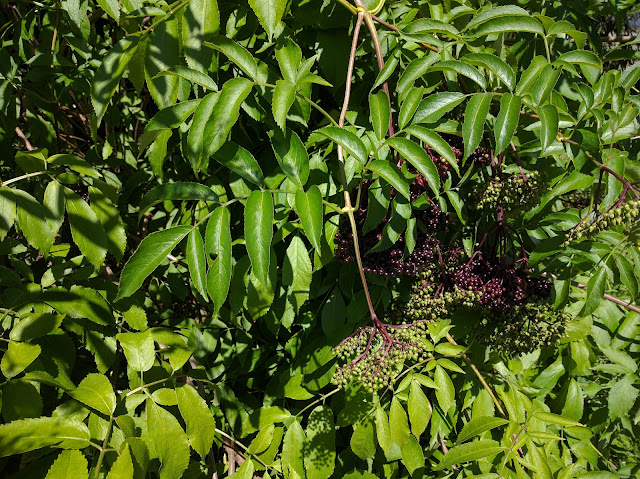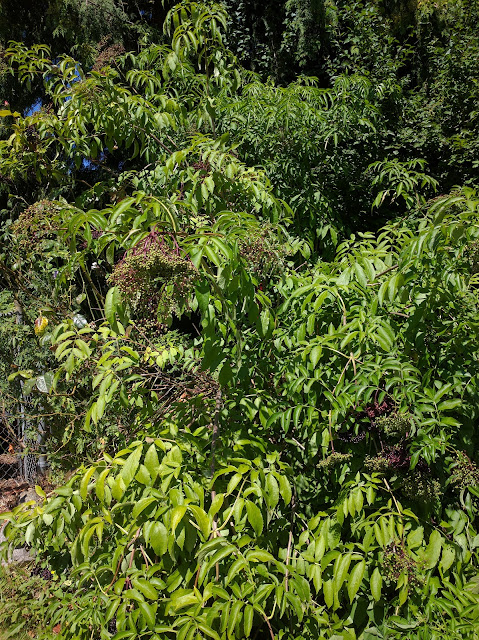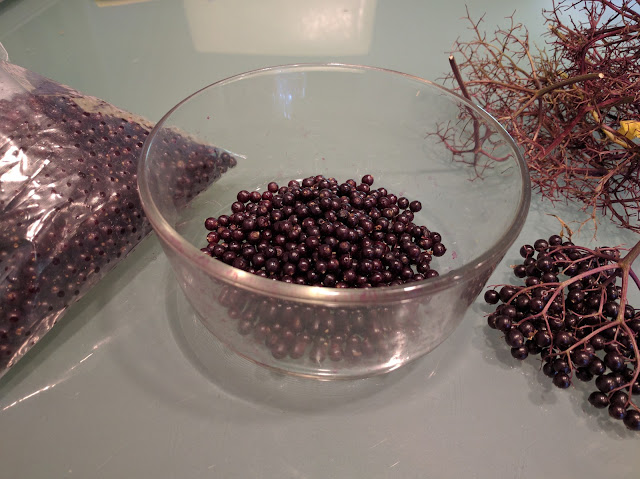While I was teaching myself permaculture a few years ago, I learned about how beneficial elderberries are, both for people and for native animal populations. I ordered two blue elderberry bushes (Sambucus Cerulea) from a local nursery, Burnt Ridge. I quickly grew to love them. Not only are they native, supporting wild bird populations, but they effortlessly produce MASSES of gorgeous, rich berry clusters that are medicinal, nutritious, and super easy to harvest and use. And they don't take ages before producing food, like most fruit trees.
Growing:
One of our elderberry plants is sandwiched between the shadows of two giant cedar trees and our house, and this bush is finally producing berries, after slowly growing for the past four years or so. We planted the other bush in a spot where it gets full eastern and southern exposure, and it's doing amazing and has been producing as many berries as we could want, for a few years now. I harvest huge bowls of berries every week for most of the summer, from this one plant. Its roots are also along the drainage ditch for our street, so it gets plenty of water without me lifting a finger.
When in bloom, the flowering umbels face the sun, but they become so heavy with ripening berries that the branches sag towards the ground. It feels like harvesting the fruit is really helping the plant out, since the enlightened branches will spring back to an upright position.
Safety:
This is a wonderful food producing native garden plant that you should know about! It's something you can harvest in the wild if you find it, or grow in your own yard if you have the space. It's important to note the difference between red and blue elderberries. Red elderberries can still be used in certain applications, but they are mostly toxic and should generally be avoided. It's easy to tell the difference between red and blue elderberry plants when they're flowering or fruiting, since blue elderberries have flat umbels, or clusters of flowers and berries. Red elderberries have more rounded umbels. And of course the berries are a completely different color. While the unripe berries, stems, and leaves of the blue elderberry do contain a toxin, the flowers and ripe berries can be liberally enjoyed. There is a chemical in the seeds that can cause nausea if eaten in large amounts, but it is rendered harmless when the berries are cooked.
As with all wild foraging, it's important to be absolutely sure of what you are eating. Use multiple sources for identifying anything new to you.
Harvesting:
The harvesting process is simple. When a berry cluster is very dark purple, use clippers to snip the whole thing off at the base of the stem. (If clusters still have green or pinkish berries towards the center, give them more time to ripen.) Gather these cut clusters together in a big bowl, and then bring them inside to remove the stems before cooking or freezing. Tiny pieces of stem are no big deal, just get all the woody bits out. While removing the stems, I like to wear nitrile medical gloves just to prevent the dark juice from getting under my nails and staining up my hands. It's temporary, and nothing worse than blackberries would do, but the juice is pretty red.
Uses:
Elderberry syrup is made by boiling the berries with water, and then straining out the skins and seeds. Honey can be added to the strained liquid. This syrup is not only great on pancakes, but it can be used medicinally to help the body fight off the flu or colds. It supports the immune system, and is great to take for nausea or diarrhea. Elderberry jam can be made as you would make any other berry jam, but you will need less sugar since the berries are not tart. Elderberry wine is a classic, which I have enjoyed but never made. The flowers can be harvested and used to make fritters or elderberry champagne. My favorite easy way to use elderberries is just to throw them in a batch of pancakes instead of blueberries. I make large batches of pancake batter, and stir in a couple cups of frozen berries just before cooking. I make pancakes like this every week, pretty much all year long. I harvest the ripe berries throughout the summer, and freeze a supply that lasts us all year.
For more on the use and history of elderberries, check out this page from the USDA. Additional information is available here, on the WSU website.
Share the article to support the site!
How To Harvest and Use Blue Elderberries
4/
5
Oleh
Mellow













2 comments
Write commentsWe scramble all over our woodlands and hillsides just to get enough elderberries for jam and cordial but it's well worth the effort because we love them so much!
ReplyAfter doing much research I find this shrub / tree to be very beneficial in any permaculture / sustainable farming piece of land or community. There are many uses not only for us but for multiple other speices as well, I am gifted in that I travel past easily a hundred or so of these large shrubs on a daily basis which are not in an area near vehicle traffic!
ReplyFor anyone interested in dandelion flower wine and other recipes please visit our blog: Growingarden.wordpress.com/